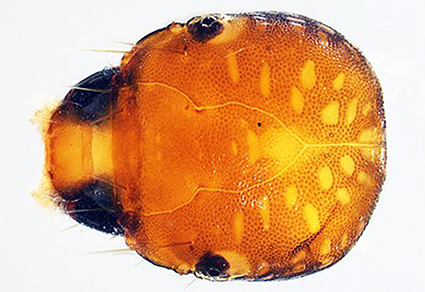Abstract
The larval morphology, life cycle, and nutritional values of Lepidostoma abruptum Banks 1931 are described and discussed. The larval case is rectangular in cross section, made of rectangular pieces of leaf. The larva of L. abruptum shares the morphological characteristics of other Lepidostoma spp. which have been described from different countries and continents. The head capsule widths of 74 specimens were measured and plotted to determine the instars of the larvae. This species is non-seasonal. In addition, the moisture (68.87%) and dry-weight nutritional values of the specimens were determined: protein (49.08%), total fat (27.13%), total dietary fiber (5.9%), omega-3 (0.15%), omega-6 (6.04%), and omega-9 (11.7%). Larvae of this species live in small debris pools dominated with leaf litter and small branches.
References
Anankware, P.J., Fening, K.O., Osekre, E.A. & Obeng-Ofori, D. (2015) Insects as food and feed. International Journal of Agricultural Research and Review, 3 (1), 43–151.
Bunlue, P., Chantaramongkol, P., Thapanya, D. & Malicky, H. (2012) The biodiversity of Trichoptera assemblage in Doi Suthep-Pui and Doi Inthanon National Parks, Chiang Mai, Thailand. Braueria, 39, 7–21.
Department of Medical Sciences (2003) Compendium of Methods for Food Analysis. Department of Medical Sciences and National Bureau of Agriculture Commodity and Food Standards, Bangkok. [unknown pagination]
Dinakaran, S., Anbalagan, S. & Balachandran, C. (2013) A new species of caddisfly (Trichoptera: Lepidostomatidae: Lepidostoma) from Tamil Nadu, India. Journal of Threatened Taxa, 5 (1), 3531–3535. https://doi.org/10.11609/JoTT.o2116.790
Grafius, E. & Anderson, N.H. (1980) Population dynamics and role of two species of Lepidostoma (Trichoptera: Lepidostomatidae) in an Oregon coniferous forest stream. Ecology, 61 (4), 808–816. https://doi.org/10.2307/1936751
Holzenthal, R.W., Blahnik, R.J., Prather, A.L. & Kjer, K.M. (2007) Order Trichoptera Kirby, 1813 (Insecta): Caddisflies. Zootaxa, 1668 (1), 639–698. https://doi.org/10.11646/zootaxa.1668.1.29
Holzenthal, R.W. & Calor, A.R. (2017) Catalog of the Neotropical Trichoptera (caddisflies). ZooKeys, 654, 1–566. https://doi.org/10.3897/zookeys.654.9516
Hwang, C.-L. (1957) Description of Chinese caddisflies (Trichoptera). Acta Entomologica Sinica, 7 (4), 373–404.
Ito, T. (2001) Description of the type species of the genus Goerodes and generic assignment of three East Asian species (Trichoptera, Lepidostomatidae). Limnology, 2, 1–9. https://doi.org/10.1007/s102010170010
Ito, T. (2011) Six new species of the genus Lepidostoma Rambur (Trichoptera, Lepidostomatidae) from Japan. Zoosymposia, 5 (1), 158–170. https://doi.org/10.11646/zoosymposia.5.1.14
Karaouzas, I. & Waringer, J. (2016) The larva of Lepidostoma doehleri Malicky 1976 (Trichoptera: Lepidostomatidae) with notes on ecology and a key to larvae for species of the genus in Greece. Zootaxa, 4189 (3), 588–592. https://doi.org/10.11646/zootaxa.4189.3.9
Latimer, G.W. Jr. (Ed.) (2016) Official Methods of Analysis of AOAC International, 20th edition. AOAC International, Rockville, Maryland.
Laudee, P. & Malicky, H. (2014) Trichoptera fauna from Nakhon Si Thammarat Range (southern Thailand), with the description of a new species of Rhyacophila Pictet, 1834 (Trichoptera: Rhyacophilidae). Aquatic Insects, 36 (3–4), 161–169. https://doi.org/10.1080/01650424.2015.1064965
Laudee, P. & Prommi, T.O. (2011) Biodiversity and distribution of Trichoptera species along the Tapee River, Surat Thani Province, southern Thailand. Zoosymposia, 5 (1), 279–287. https://doi.org/10.11646/zoosymposia.5.1.21
McCafferty, W.P. (1981) Aquatic Entomology: The Fisherman’s and Ecologists’ Illustrated Guide to Insects and Their Relatives. Jones and Bartlett Publishers. Inc., Boston, Massachusetts, 448 pp.
Malicky, H. (2010) Atlas of Southeast Asian Trichoptera. Biology Department, Faculty of Science, Chang Mai University, Chang Mai, 364 pp.
Malicky, H. (2021) Phänologische Studien an tropischen Trichopteren: Chiangmai Zoo (Thailand). Braueria, 48, 46–58.
Morse, J.C., McCafferty, W.P., Stark, B.P. & Jacobus, L.M. (Eds.) (2017) Larvae of the Southeastern USA Mayfly, Stonefly, and Caddisfly Species (Ephemeroptera, Plecoptera, and Trichoptera). Biota of South Carolina. Vol. 9. Technical Bulletin 1109. PSA Publishing, Clemson University, Clemson, South Carolina, 482 pp.
Morse, J.C., Frandsen, P.B., Graf, W. & Thomas, J.A. (2019) Diversity and Ecosystem Services of Trichoptera. In: Morse, J.C. & Adler, P.H. (Eds.), Diversity and Ecosystem Services of Aquatic Insects. Insects, 10 (5), pp. 125. https://doi.org/10.3390/insects10050125
Mosely, M.E. (1949) The Indian caddis flies (Trichoptera). Parts IX, X. Journal of the Bombay Natural History Society, 48, 230–245.
Oláh, J. (1993) Seven new Trichoptera from the Gombak River system, Malaysia. Folia Entomologica Hungarica, 54, 93–100.66
Reinecke, K.J. & Owen Jr, R.B. (1980) Food use and nutrition of black ducks nesting in Maine. The Journal of Wildlife Management, 44, 549–558. https://doi.org/10.2307/3808002
Riggi, L. G., Veronesi, M., Goergen, G., MacFarlane, C. & Verspoor, R.L. (2016) Observations of entomophagy across Benin—Practices and potentials. Food Security, 8 (1), 139–149. https://doi.org/10.1007/s12571-015-0509-y
Shan, L-n. & Yang, L.-F. (2005) Descriptions of the larvae of Lepidostoma fui (Huang) and L. arcuatum (Huang) (Trichoptera: Lepidostomatidae). Nanjing Nongye Daxue Xuebao, 28, 44–47.
Terefe, Y., Vitecek, S. & Graf, W. (2018) Description of the larva of Oecetis mizrain Malicky & Graf, 2012 (Trichoptera, Leptoceridae) and Lepidostoma scotti (Ulmer, 1930) (Trichoptera, Lepidostomatidae) from Chilimo Forest, Central Ethiopia. ZooKeys, 766, 63–77. https://doi.org/10.3897/zookeys.766.24544.figure25
Thapanya, D., Chantaramongkol, P. & Malicky, H. (2004) An updated survey of caddisflies (Trichoptera, Insecta) from Doi Suthep-Pui and Doi Inthanon National Parks, Chiang Mai Province, Thailand. Tropical Natural History, 4 (1), 21–40.
Ulmer, G. (1907) Trichopteren. Collections Zoologiques du Baron Edm. de Selys Longchamps, 6 (I), 1–102.
Ulmer, G. (1926) Beiträge zur Fauna sinica III. Trichopteren und Ephemeropteren. Archiv für Naturgeschichte, Abteilung A, 91, 19–110.
Weaver III, J.S., Arefina-Armitage, T.I. & Armitage, B. (2010) The caddisfly family Lepidostomatidae (Trichoptera) in Vietnam. Denisia, 29, 407–435.
Wiggins, G.B. (1996) Larvae of the North American Caddisfly Genera (Trichoptera). 2nd Edition. University of Toronto Press, Toronto, 472 pp. https://doi.org/10.3138/9781442623606
Williams, D.D. & Williams, S.S. (2017) Aquatic insects and their potential to contribute to the diet of the globally expanding human population. Insect, 72, 1–20. https://doi.org/10.3390/insects8030072
Xiaoming, C., Ying, F., Hong, Z. & Zhiyong, C. (2010) Review of the nutritive value of edible insects. Forest Insects as Food: Humans Bite Back, 85, 1–228.
Yang, W.-F. & Yang, L.-F. (2002) A study on biology of Lepidostoma flavum Ulmer and Phryganopsyche latipennis Banks (Trichoptera, Integripalpia). Nanjing Nongye Daxue Xuebao, 25, 61–65.


